Taylor External Fixator Video
Taylor External Fixator PDF
Taylor External Fixator Specification
| Name | NO. | Picture | Unit |
| Tibial And Femur Fracture Ring Fixator | GX301001 | 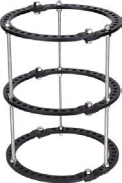 | Set |
| Lower limb lengthening external Fixator | GX301003 | 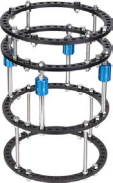 | Set |
| Tibial And Femur Fracture Ring Fixator-l | GX301004 | 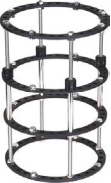 | Set |
| External Elbow Joint Fixator | GX301005 | 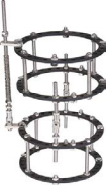 | Set |
| Tibia And Femur Fixation Orthopedics Fixator | GX301006 | 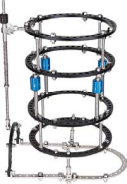 | Set |
| Taylor External Fixator | GX301007 | 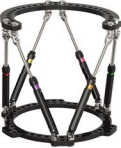 | Set |
| Knee Joint Fixator | GX301008 | 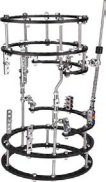 | Set |
| Ankle Joint Fixator | GX301009 | 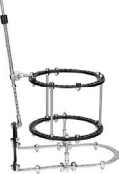 | Set |
Advantages of XC Medico's Products

CNC Preliminary Processing
The computer numerical control technology is used to precisely process orthopedic products. This process has the characteristics of high precision, high efficiency, and repeatability. It can quickly produce customized medical devices that conform to the human anatomical structure and provide patients with personalized treatment plans.
| 
Product Polishing
The purpose of orthopedic products polishing is to improve the contact between the implant and human tissue, reduce stress concentration, and improve the long-term stability of the implant. | 
Quality Inspection
The mechanical properties test of orthopedic products is designed to simulate the stress conditions of human bones, evaluate the load-bearing capacity and durability of implants in the human body, and ensure their safety and reliability. |

Product Package
Orthopedic products are packaged in a sterile room to ensure that the product is encapsulated in a clean, sterile environment to prevent microbial contamination and ensure surgical safety.
|  Product Warehouse Product Warehouse
The storage of orthopedic products requires strict in-and-out management and quality control to ensure product traceability and prevent expiration or wrong shipment. |  Sample Room Sample Room
The sample room is used to store, display and manage various orthopedic products samples for product technology exchanges and training. |
The Process To Cooperate With XC Medico
1. Ask Xc Medico Team For Tibia And Taylor External Fixator Product Catalog.
2. Choose Your Interested Tibia And Taylor External Fixator Product.
3. Ask For A Sample To Test Tibia And Taylor External Fixator.
4.Make An Order Of XC Medico's Tibia And Taylor External Fixator.
5.Become A Dealer Of XC Medico's Tibia And Taylor External Fixator.
The Advantages To Be A Dealer Or Wholesaler Of XC Medico
1.Better Purchase Prices Of Tibia And Taylor External Fixator.
2.100% The Highest Quality Tibia And Taylor External Fixator.
3. Less Ordering Efforts.
4. Price Stability For The Period Of Agreement.
5. Sufficient Taylor External Fixator.
6. Quick And Easy Assessment Of XC Medico's Taylor External Fixator.
7. A Globally Recognized Brand - XC Medico.
8. Fast Access Time To XC Medico Sales Team.
9. Additional Quality Test By XC Medico Team.
10. Track Your XC Medico Order From Start To Finish.
Taylor External Fixator: A Comprehensive Guide
The Taylor External Fixator (TEF) is an advanced orthopedic device used for managing complex fractures, deformities, and limb length discrepancies. As a dynamic external fixation system, it provides surgeons with unparalleled precision and versatility in achieving optimal outcomes for patients. This guide explores the TEF’s features, applications, advantages, and future prospects, serving as an authoritative resource for medical professionals and researchers.
What is Taylor External Fixator?
The Taylor External Fixator (TEF) is a specialized orthopedic device designed to stabilize and correct fractures and deformities of the long bones, such as the femur, tibia, and humerus. Based on the principles of the Ilizarov technique, the TEF uses external frames and adjustable struts to provide accurate three-dimensional (3D) control over bone alignment, lengthening, and rotation.
The TEF is particularly effective for treating severe fractures, congenital deformities, and post-traumatic conditions where traditional fixation methods may fall short. Its modular design allows for customization to the patient’s specific anatomical and pathological needs.
Taylor External Fixator Features
3D Adjustable Struts
Provides precise control over bone alignment, length, and angular correction.
Computer-Assisted Planning
Compatible with software for preoperative and postoperative planning, ensuring precise treatment strategies.
Modular Frame Design
Allows customization to accommodate different bone lengths, shapes, and fracture patterns.
High-Durability Materials
Constructed from lightweight, biocompatible materials such as titanium and carbon fiber to reduce patient discomfort while ensuring stability.
Multiplanar Correction
Enables simultaneous correction of multiple deformities, including angular, rotational, and length discrepancies.
Radiolucent Components
Facilitates imaging for accurate monitoring of fracture alignment and healing progress.
Taylor External Fixator Advantages
Precision in Deformity Correction
Allows for highly accurate adjustments in multiple planes to restore anatomical alignment.
Dynamic Adjustability
Enables modifications during the healing process without the need for additional surgical intervention.
Reduced Soft Tissue Damage
The external application minimizes trauma to surrounding muscles, tendons, and neurovascular structures.
Enhanced Bone Regeneration
Promotes osteogenesis by maintaining controlled stress at the fracture site, accelerating healing.
Versatile Applications
Effective for managing a broad spectrum of conditions, from fractures to limb lengthening and deformity correction.
Facilitates Early Weight-Bearing
Some configurations allow patients to bear weight during recovery, promoting mobility and reducing rehabilitation time.
Taylor External Fixator Treatment of Fracture Types
Complex Fractures
Stabilizes comminuted and segmental fractures while maintaining alignment.
Limb Length Discrepancies
Facilitates gradual bone lengthening to address congenital or acquired inequalities.
Congenital Deformities
Corrects angular and rotational deformities, such as bow legs or knock knees.
Non-Union and Malunion Fractures
Provides structural support for bones that fail to heal properly.
Post-Traumatic Deformities
Restores functionality and alignment in limbs affected by trauma.
Bone Defects
Enables distraction osteogenesis to regenerate missing or deficient bone tissue.
Risks of Taylor External Fixator Surgery
Pin Tract Infections
A common complication requiring regular cleaning and monitoring of pin sites.
Joint Stiffness
Prolonged immobilization may lead to reduced range of motion, necessitating physical therapy.
Delayed Union or Non-Union
Inadequate adjustments or poor patient compliance can hinder bone healing.
Soft Tissue Irritation
The presence of external components may cause discomfort or irritation to surrounding tissues.
Mechanical Failures
Rare instances of strut breakage or pin loosening may require reconfiguration.
Psychological Impact
The visible and prolonged nature of the device can affect patient morale and compliance.
Taylor External Fixator Future Marke
Rising Trauma Cases
Increasing road accidents and high-energy injuries are driving demand for advanced fixation solutions.
Technological Advancements
Integration of computer-aided design and robotic assistance is enhancing the accuracy and efficiency of TEF applications.
Global Aging Population
An aging demographic is contributing to higher rates of fractures and degenerative conditions, increasing demand for orthopedic devices.
Emerging Markets
Growing healthcare infrastructure in developing countries is expanding access to advanced orthopedic technologies.
Minimally Invasive Trends
The demand for less invasive surgical options is promoting the use of external fixation systems.
Summary
The Taylor External Fixator represents a breakthrough in orthopedic care, offering unmatched precision and versatility in the management of complex fractures, deformities, and limb discrepancies. Its advanced features, including 3D adjustability and computer-assisted planning, make it a critical tool for surgeons worldwide. While the device carries certain risks, careful surgical planning and diligent follow-up care ensure successful outcomes. As technology and market demand continue to evolve, the TEF is set to remain a cornerstone of advanced orthopedic treatment, delivering improved functionality and quality of life for patients.
Warm reminder: This article is for reference only and cannot replace the doctor's professional advice. If you have any questions, please consult your attending physician.
English
Русский
简体中文
繁體中文
العربية
Français
Español
Português
Deutsch
italiano
日本語
한국어
Nederlands
Tiếng Việt
ไทย
Polski
Türkçe
አማርኛ
ພາສາລາວ
ភាសាខ្មែរ
Bahasa Melayu
ဗမာစာ
தமிழ்
Filipino
Bahasa Indonesia
magyar
Română
Čeština
Монгол
қазақ
Српски
हिन्दी
فارسی
Kiswahili
Slovenčina
Slovenščina
Norsk
Svenska
українська
Ελληνικά
Suomi
Հայերեն
עברית
Latine
Dansk
اردو
Shqip
বাংলা
Hrvatski
Afrikaans
Gaeilge
Eesti keel
Māori
සිංහල
नेपाली
Oʻzbekcha
latviešu
অসমীয়া
Aymara
Azərbaycan dili
Bamanankan
Euskara
Беларуская мова
भोजपुरी
Bosanski
Български
Català
Cebuano
Corsu
ދިވެހި
डोग्रिड ने दी
Esperanto
Eʋegbe
Frysk
Galego
ქართული
guarani
ગુજરાતી
Kreyòl ayisyen
Hausa
ʻŌlelo Hawaiʻi
Hmoob
íslenska
Igbo
Ilocano
Basa Jawa
ಕನ್ನಡ
Kinyarwanda
गोंगेन हें नांव
Krio we dɛn kɔl Krio
Kurdî
Kurdî
Кыргызча
Lingala
Lietuvių
Oluganda
Lëtzebuergesch
Македонски
मैथिली
Malagasy
മലയാളം
Malti
मराठी
ꯃꯦꯇꯥꯏ (ꯃꯅꯤꯄꯨꯔꯤ) ꯴.
Mizo tawng
Chichewa
ଓଡ଼ିଆ
Afaan Oromoo
پښتو
ਪੰਜਾਬੀ
Runasimi
Gagana Samoa
संस्कृत
Gaelo Albannach
Sepeti
Sesotho
chiShona
سنڌي
Soomaali
Basa Sunda
Wikang Tagalog
Тоҷикӣ
Татарча
తెలుగు
ትግንያውያን
Xitsonga
Türkmençe
संस्कृत
ئۇيغۇرچە
Cymraeg
isiXhosa
ייִדיש
Yorùbá
isiZulu
























 Product Warehouse
Product Warehouse Sample Room
Sample Room









